Personal Fouls
Personal fouls are acts of unnecessary roughness that endanger the safety of another player.
Flagrant personal fouls involve physical contact so extreme or deliberate that it places an opponent in danger of catastrophic injury. Flagrant personal fouls automatically trigger a video review by the conference for possible additional sanctions before the next scheduled game. Before the game, during the game, and between periods all flagrant personal fouls require that the offending player be disqualified or ejected from the game plus a 15-yard penalty against the player's team and an automatic first down for the opponents.
If, on a conference review, flagrant personal fouls are seen that were not called by the on field officiating crew, the conference may impose sanctions prior to the next scheduled game.
Disqualified Player: Must leave the game and cannot play for the remainder of the game. May stay on the sidelines with the rest of the team. Ejected Player: Must leave the game and be escorted off the playing field to the locker room by team personnel before the next play begins, where he must stay out of view of the field until the end of the game.
Roughing the Passer: 15 yards: The following actions indicate roughing the passer:
1. A defensive player cannot rough the passer, or use forcible contact that is avoidable when it is obvious the ball has already been thrown.
2. Targeting
3. Forcible contact to the head or neck area
4. Forcibly driving the passer to the ground and landing on him with action that punishes the player.
5. No defensive player may forcibly hit the passer in the knee area or below.
Blocking the kicker: 15 yards: A defensive player cannot block the kicker until the ball has been touched by another player, an official, or the ground and the kicker has advanced 5 yards.
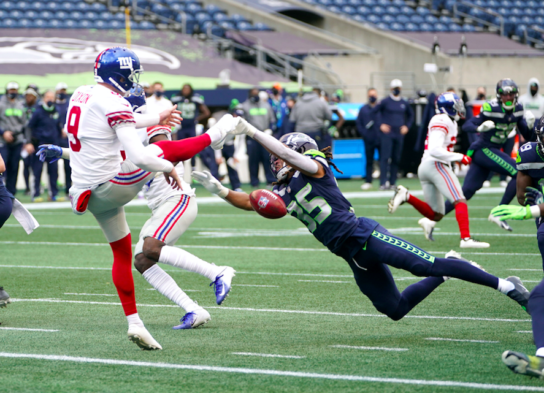 The kick is being blocked and the defensive player is close to the kicker's foot/leg.
The kick is being blocked and the defensive player is close to the kicker's foot/leg.Blocking below the waist: 15 yards: Blocking below the waist is legal as long as it is from the front. An offensive player may not block below the waist 5 yards or more beyond the neutral zone. During a kicking play or after a change of possession, blocking below the waist is illegal by all players except against the ball carrier.
Late Hit, Action out of bounds: 15 yards:
1. There cannot be piling on, falling on, or throwing the body on an opponent after the ball becomes dead.
2. The defense may not block the runner when he is clearly out of bounds.
3. It is illegal for a defensive player who is clearly out of bounds to initiate a block against an offensive player who is also clearly out of bounds.
Helmet and face mask fouls: 15 yards
1. Cannot have continuous contact with the opponent’s face, helmet (including facemask) or neck with hands or arms.
2. An opponent cannot grab then twist, turn or pull the facemask, chin strap, or any opening in the helmet. This could cause injury to the neck and spine ranging from simple muscle strain to catastrophic neck injury that results in paralysis.
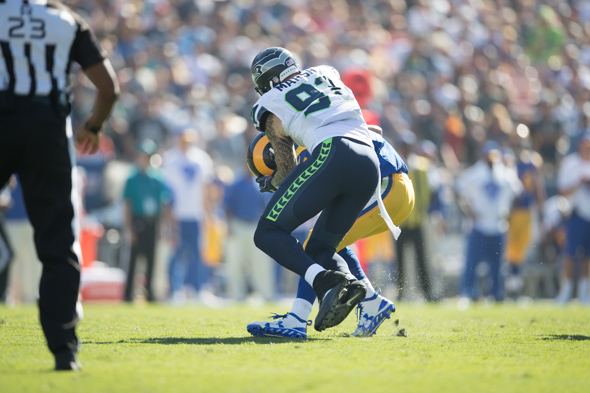 Player grasping the facemask of an opposing player
Player grasping the facemask of an opposing playerClipping: 15 yards: Throwing the body across the back of the leg of an eligible receiver or charging or falling into the back of an opponent below the waist after approaching him from behind, unless the player is a runner, is illegal.
Chop Blocking: 15 yards: When one opponent blocks a player high and a second opponent blocks the player low. This has obvious potential for injury.
Striking fouls and tripping: 15 yards: Nobody can strike an opponent with the knee, strike an opponent’s helmet (including face mask), head or neck or any other body part with any part of the extended hand or arm, or gouge the opponent. Nobody can strike an opponent with the foot. Tripping, intentionally using the foot or lower leg to obstruct an opponent below the knee, is illegal.
Leverage and leaping: 15 yards: A defensive player cannot step on, jump on, or stand on a teammate or an opponent to gain an advantage. A defensive player may not pick up a teammate for additional height or to be elevated, propelled, or pushed. A defensive player may not use one hand on a teammate to enable them to hurdle over them (like playing leap frog).
No player may position himself with his feet on the back or shoulders of a teammate before a snap!
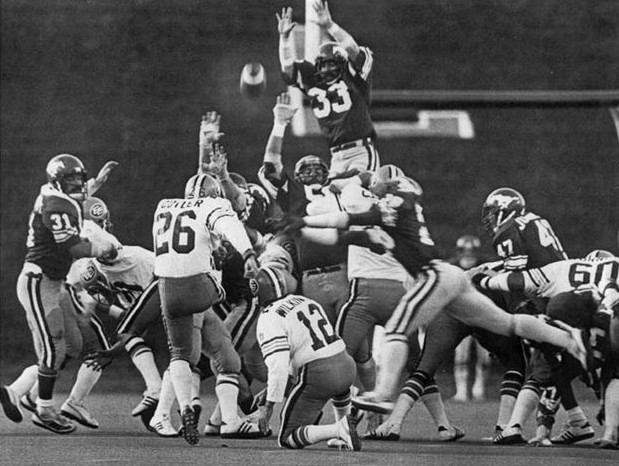 It is illegal to be lifted up or to climb on top of another player in an attempt to block a kick.
It is illegal to be lifted up or to climb on top of another player in an attempt to block a kick.Horse collar tackle: 15 yards: It is illegal to grab the inside back collar of the shoulder pads or jersey, name plate area, or inside collar of the side of the shoulder pads or jersey and immediately pull the ball carrier down.
Contact against a snapper: 15 yards: A defensive player may not make contact with the snapper until one full second has elapsed after the snap.
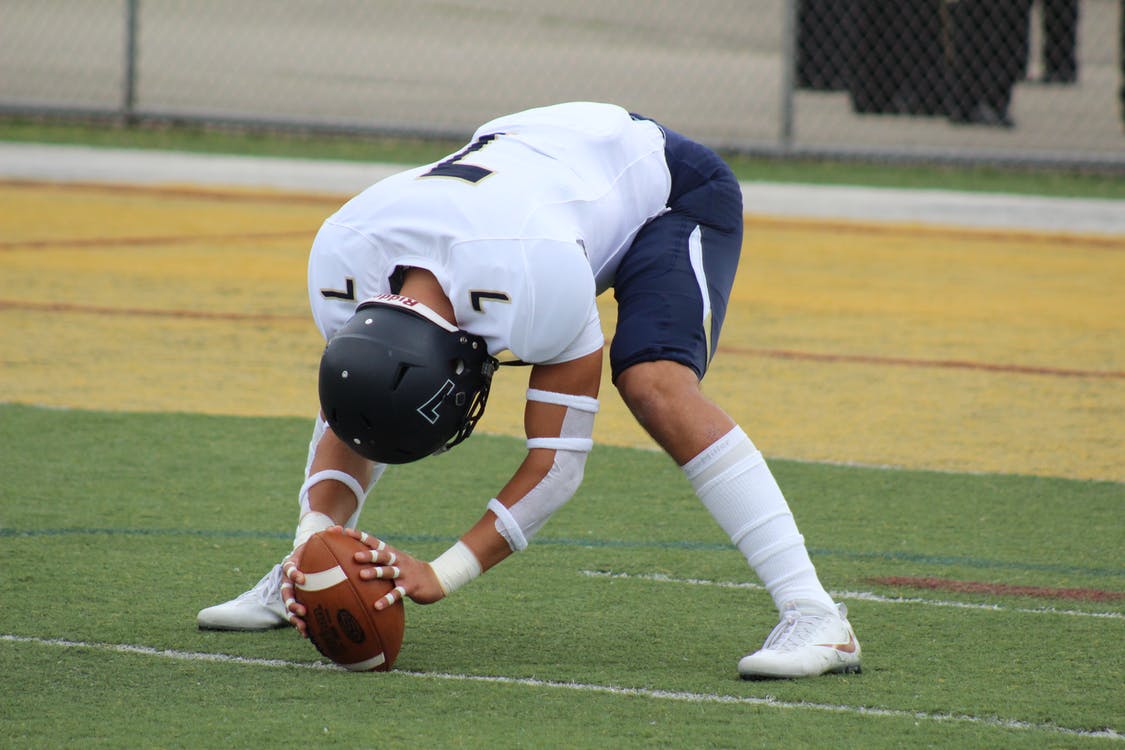 A snapper is in a vulnerable position when hiking the ball.
A snapper is in a vulnerable position when hiking the ball.Contact against an opponent out of the play: 15 yards: A defensive player cannot run into or tackle a receiver when the pass is obviously not catchable. No player can run into or throw himself against an opponent who is obviously out of the play.
Hurdling: 15 yards: Running forward and leaping across the line of scrimmage in an obvious attempt to block a field goal or extra point kick. Any attempt by a player to jump with one or both feet or knees foremost over an opponent who is still on his feet.
An offensive runner may hurdle an opponent without penalty.
Roughing or running into a kicker or holder: 15 yards: When it is obvious that a kick is taking place, nobody can run into or rough the holder or kicker of a place kick. According to the NCAA:
1. Roughing is a live-ball personal foul that endangers the kicker or holder.
2. Running into the kicker or holder is a live-ball foul that occurs when the kicker or holder is displaced from his kicking or holding position but is not roughed.
3. Incidental contact with a kicker or holder is not a foul.
4. The kicker’s protection under this rule ends
(a)when he has had a reasonable time to regain his balance; or
(b)when he carries the ball outside the tackle box before kicking.
5. When a defensive player’s contact against the kicker or holder is caused by an opponent’s block (legal or illegal), there is no foul for running into or roughing.
6. A player who makes contact with the kicker or holder after touching the kick is not charged with running into or roughing the kicker.
7. When a player other than one who blocks a scrimmage kick runs into or roughs the kicker or holder, it is a foul.
8. When in question whether the foul is running into or roughing, the foul is roughing.
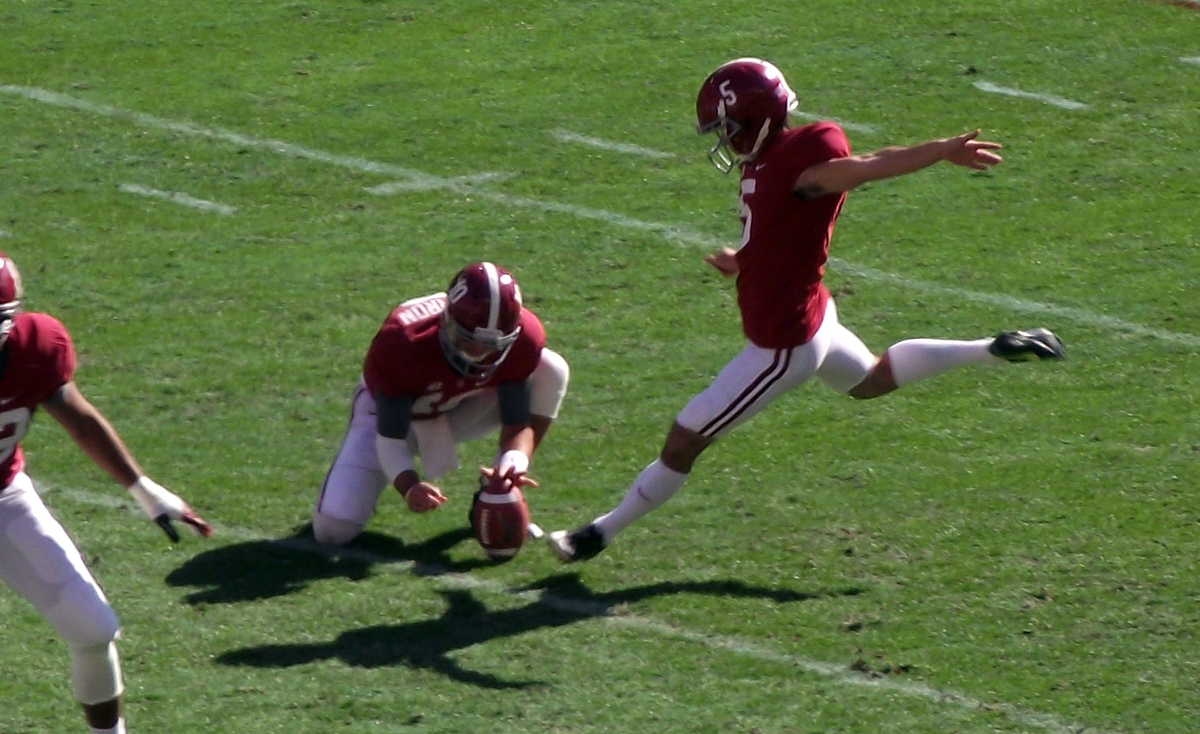 Both holder and kicker are concentrated on the ball and become vulnerable to injury
Both holder and kicker are concentrated on the ball and become vulnerable to injuryBlind side block: 15 yards: When a player is blocked by an opponent outside his field of vision or in a way that the player cannot reasonably protect himself from the block.
Targeting: 15 yards, automatic first down, disqualification of player:
Targeting means that a “…player takes aim at an opponent for purposes of attacking with forcible contact that goes beyond making a legal tackle or legal block or playing the ball” (NCAA.org).
A player may not make forcible contact with the crown of the helmet. No player can make forcible contact to the head and neck area of a defenseless opponent with the helmet, forearm, hand, fist, elbow or shoulder. To call a targeting foul, one of the following indicators must be present:
1. Launch—A player leaving his feet to attack an opponent by an upward and forward thrust of the body to make forcible contact in the head or neck area.
2. A crouch followed by an upward and forward thrust to attack with forcible contact at the head or neck area, even though one or both feet are still on the ground.
3. Leading with helmet, shoulder, forearm, fist, hand or elbow to attack with forcible contact at the head or neck area.
4. Lowering the head before attacking by initiating forcible contact with the crown of the helmet.
A defenseless opponent is defined by the NCAA as:
· A player in the act of or just after throwing a pass.
· A receiver attempting to catch a forward pass or in position to receive a backward pass, or one who has completed a catch and has not had time to protect himself or has not clearly become a ball carrier.
· A kicker in the act of or just after kicking a ball, or during the kick or the return.
· A kick returner attempting to catch or recover a kick, or one who has completed a catch or recovery and has not had time to protect himself or has not clearly become a ball carrier..
· A player on the ground.
· A player obviously out of the play.
· A player who receives a blind-side block.
· A ball carrier already in the grasp of an opponent and whose forward progress has been stopped.
· A quarterback any time after a change of possession
· A ball carrier who has obviously given himself up and is sliding feet first to the ground.
 Perfect example of a defenseless player who is not in a position to defend himself
Perfect example of a defenseless player who is not in a position to defend himselfFor targeting fouls in the first half of a game, the player is disqualified for the remainder of the game. For targeting fouls in the second half of a game, the player is disqualified for the first half of the next scheduled game.
If is it
the last game of the season, the disqualification rolls over to the first half
of any postseason game or to the first game of the next season, providing the
player has eligibility remaining.
For third and subsequent targeting fouls within the same season, the player will receive an automatic one game suspension for the next game.
If is it the last game of the season, the suspension rolls over to the first half of any postseason game or to the first game of the next season, providing the player has eligibility remaining.
All targeting calls must be reviewed by Instant Replay.